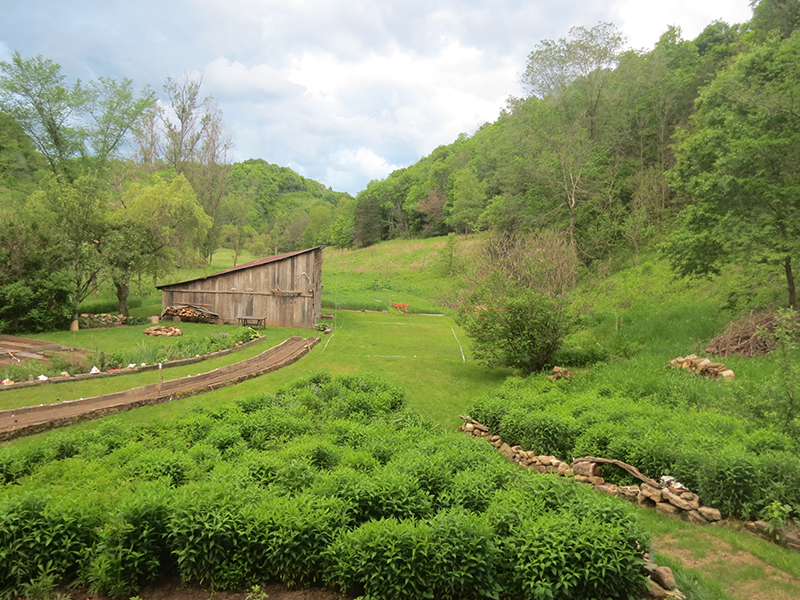
Spring in the Kickapoo Valley

It’s been a beautiful spring—strange yet beautiful as springtime always is. It was strange that March and April seemed to trade places on the calendar. A very mild month of March made me think we would be easing into spring with the best yet to come. The warm April showers didn’t come, though; instead it just got colder and the firewood pile was again visited more frequently.
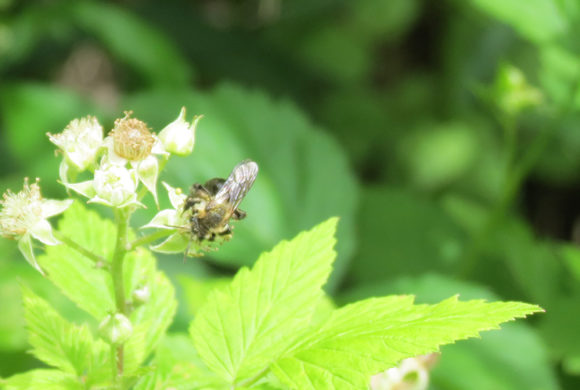
As it would turn out, the two bluebirds that visited my valley the second week in March would be the last bluebirds I would see this spring. Now that’s strange! There have been 2 or 3 pairs of nesting bluebirds in this valley every spring for the last 20 years, and all of a sudden they don’t show up. I’ve asked many of my friends, and so far no one has seen them.
Only one pair of house wrens have come this year. They have their pick of 30 bird houses around my home and throughout the 8 acres of prairie meadow. I love their busy chattering and lovely warbling songs. In a natural world where every living creature lives in the moment, the Jenny wren steps up the tempo of life and lives in micro-moments during its nesting season.
I guess only a fool would try to predict the weather these days. I’m often asked what the weather will bring in the coming weeks. My response is always the same. I take it as it comes, one day at a time, though it’s not quite like living in the moment like all the wild ones, but I’ve got it whittled down to each day. When I first step out on the porch each morning I greet the day and take in the weather it has brought to me.
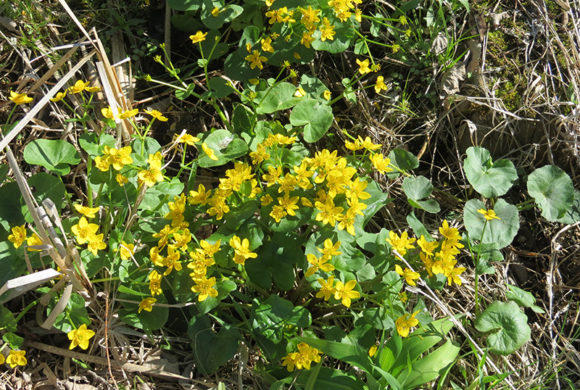
One of my favorite mid-spring wild flowers is the bright yellow blossom of the marsh marigold. I first learned of them from my mother, who taught me they liked to be called cowslips. A few decades ago, folks around here would often remark on how beautiful the cowslips were each spring. It’s become a rare treat to spot any in the area these days. I was expecting to see a lot of pollinating insects on the pretty yellow blossoms. There were a few tiny bees and flies, but not many. Is this possibly another case of off-kilter timing of modern insect hatches? It’s something I’ve noticed over the past decade and more: insect hatches are mis-timed with the blooming of flowers. Again, strange.
By May 4th, we hadn’t had any measurable rain here for weeks. I started to hear the dreaded word, “drought,” in conversations with my neighbors. The effects are already obvious on the landscape. Warm, dry weather has tipped my modest lawn more toward weed bed than grass—and that more brown than the expected springtime green. Wet areas, including backwaters, sloughs, ponds, and potholes have all dried up. There aren’t nearly as many of these places left to begin with, so a long list of aquatic life forms are in peril now. I cringe when I think of what happens to all those tadpoles, frog and toad eggs, salamanders, dragonfly larvae, and so on. Think of the swallows and bats who hunt for flying insects over these still waters. When the water is gone the insects will follow, with the bats and swallows right behind. The repercussions from a drought can mean pressure for many already stressed wildlife species.
There are more roadkill deer than I’ve ever seen—and I’ve been keeping track of wildlife roadkill for 50 years. I don’t drive often, but enough to notice a large decrease of dead songbirds along the roads. While in one sense, that’s a good thing, in another it says to me that there are simply far fewer migrating songbirds in springtime now.
My bird feeders have been busy, but a three-day heat spell caused a lull. Orioles come for the pulp of the juicy orange halves I place on my window feeders. A couple of sassy catbirds wait their turn for some orange, too. A male red-headed woodpecker doesn’t wait in line for anyone, and he doesn’t think twice about flying in for the orange bounty. I can always tell when the red-bellied woodpecker eggs hatch because they start flying back to their nests with their bills filled with orange pulp for the young.
Red-winged blackbirds, grosbeaks, cardinals, nuthatches, chickadees, woodpeckers, doves, bluejays, and finches all take advantage of the handout of sunflower seeds. Of all the birds who come to the feeders, there’s only one that I haven’t seen at the suet feeders this spring: the mourning dove. Birds that I would never expect to see eating suet are now eating it. The orioles, catbirds, and finches are supplementing their diets with suet. The first indigo bunting of this spring seemed happy for the free suet. For sure, this recent change in many birds’ diets is food for thought.
A single junco showed up at the feeders on May 11—the latest I’ve ever seen a spring junco here.
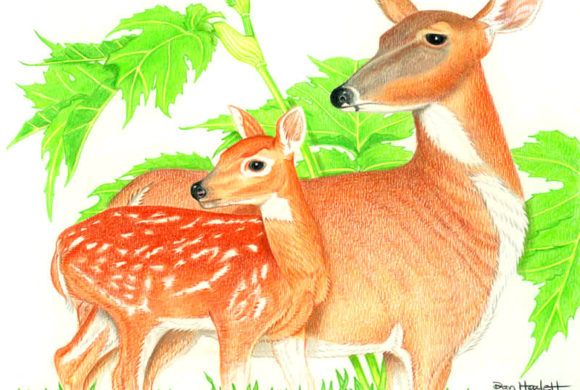
Little spotted fawns are poking their heads up above the tall grass and taking in their beautiful new world. Families of Canada geese search for safe places on the still waters—which are drying up in spring 2021. Cranes may be struggling a little; I’ve seen only one crane chick as of May 25.
I did see an unexpected bird the other day as I drove slowly along the river road. I’ve never seen an American bittern in the Kickapoo Valley, but there it was flying across the gravel road right in front of me. I have many fond memories of these wonderfully elusive marsh birds when I lived in Rock, Dane, and Green counties decades ago.
Yes, it has been a memorable spring, both in its wonder and in its strangeness. I can’t help wondering where the bluebirds have gone. I haven’t seen a single warbler yet of any kind, but I never know who might show up tomorrow.

The lawn greened up overnight after a half-inch of rain the third week of May. Of course, it got cooler for a couple of days after the rain and then downright cold two nights in a row. I knew that with no cloud cover, a serious frost was in store. I spent over an hour covering young plants and seedlings in my gardens, trying to outsmart ol’ Jack Frost. When I stepped out on the porch at 5:30 a.m., everything was covered with white frost, and I was glad I’d put in the plant-covering effort—the thermometer read 28 degrees. The following night Jack went for a repeat, but only made it down to 33 degrees, just bordering on frost, though still too cold for uncovered new plants.
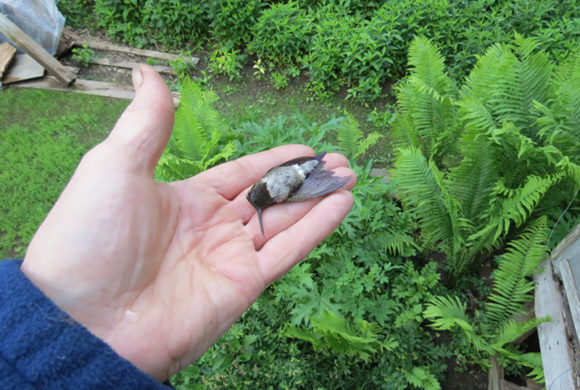
It wasn’t much of a tragedy to lose a few plants, but what broke my heart was finding the still body of a ruby-throated hummingbird. I held his weightlessness in my hand and tried to guess what he had succumbed to. He had been next to a bed of bee-balm, lying on the grass. Had the frost bit hard enough to kill him, maybe? With the end of my little finger I gently tried to feel his breast bone (keel) to see if I could tell if he had been well fed. It seemed a little sharp, but was he fat enough to ward off the frost during his long night? I don’t really know what happened to him, so all I can do is guess, I guess.
‘Till next time—remember to kick off your shoes as you go out the back door!
Naturally Yours,
Dan
